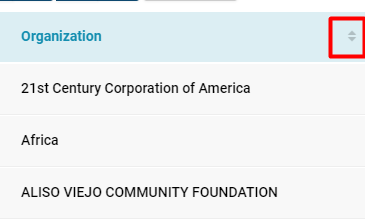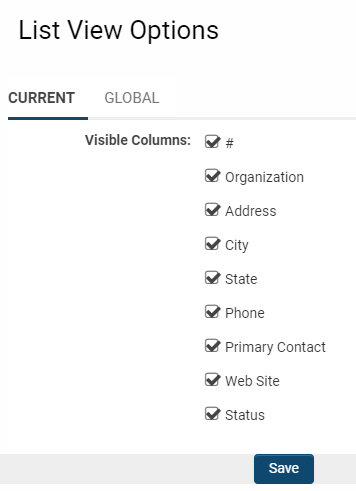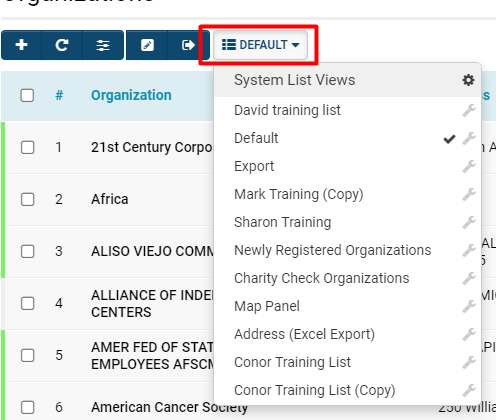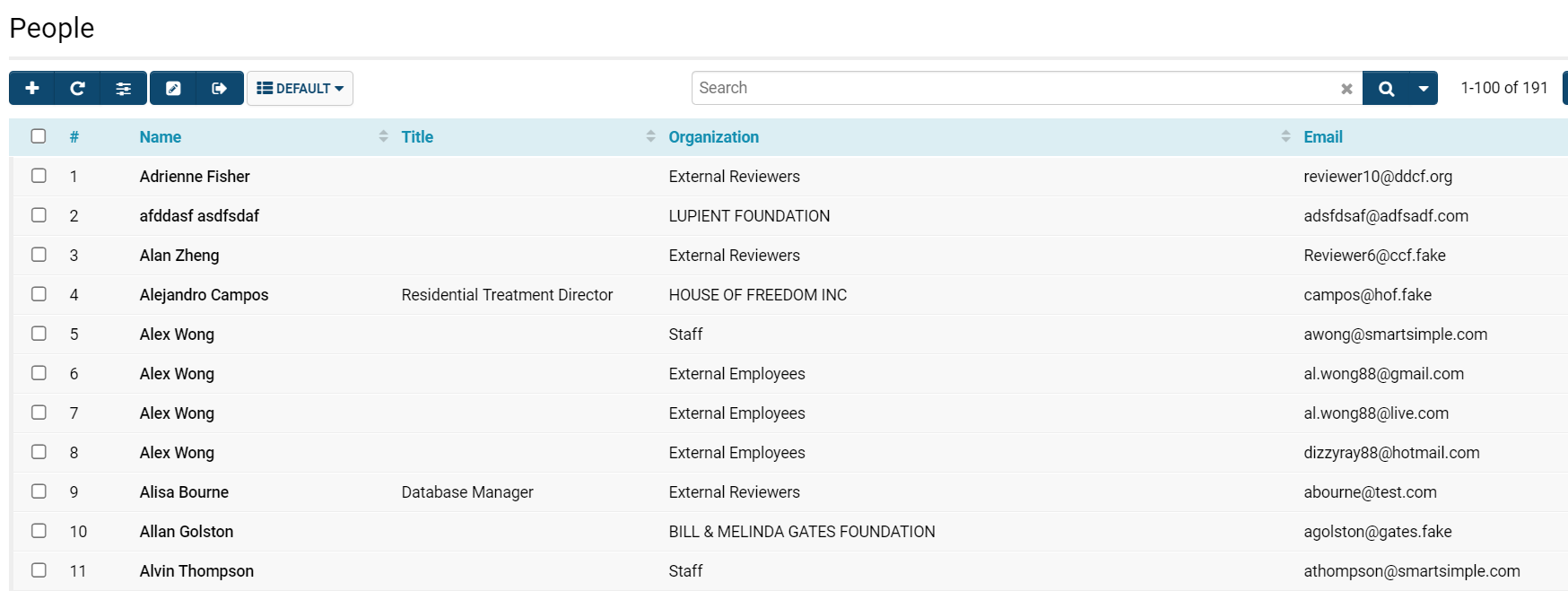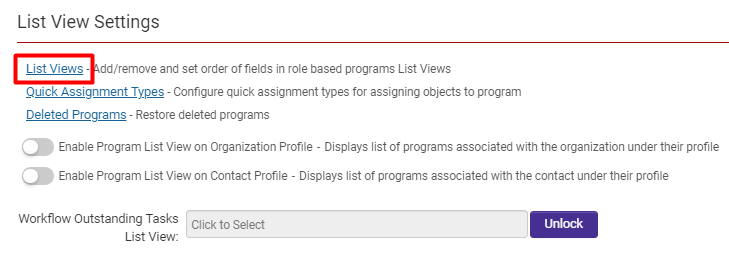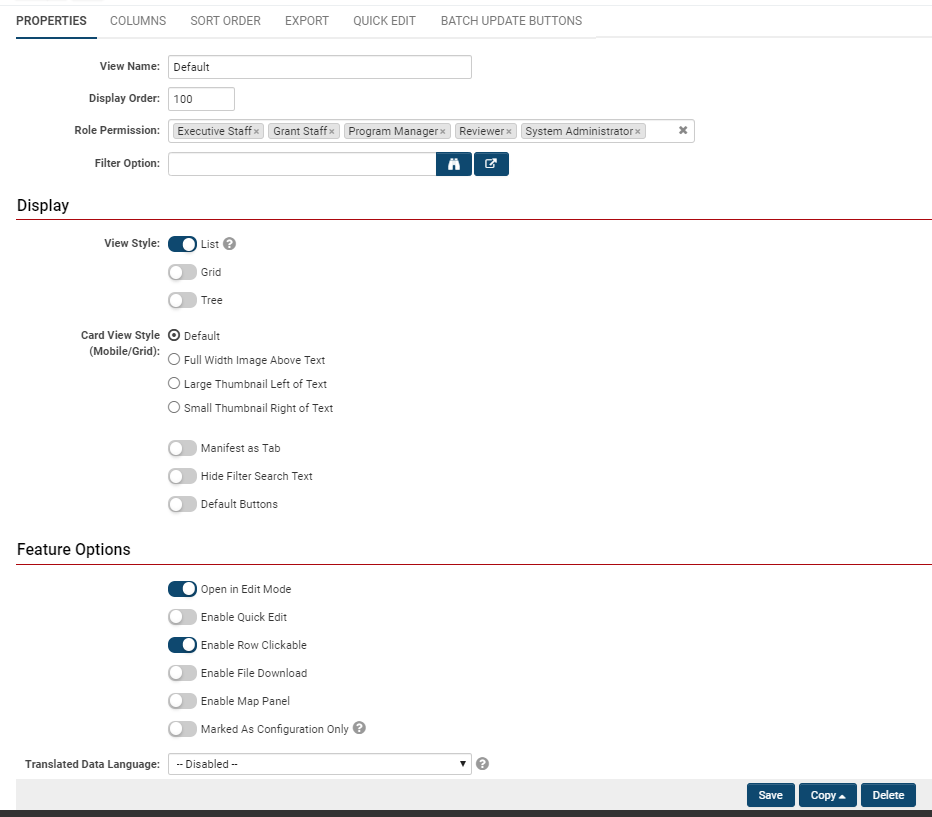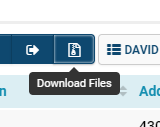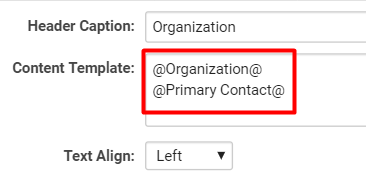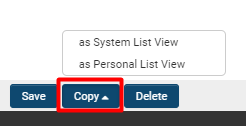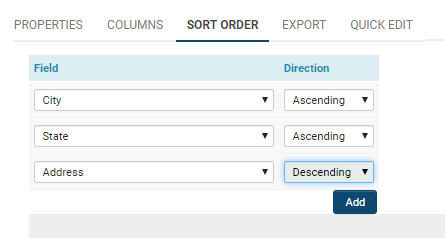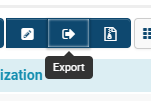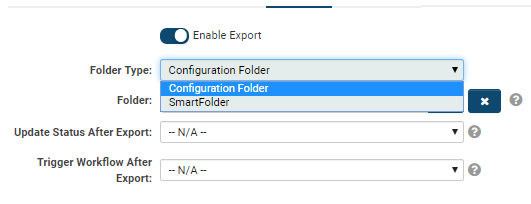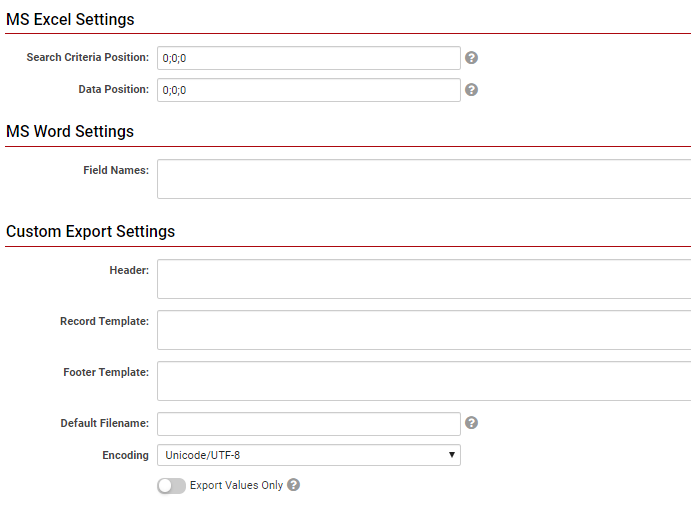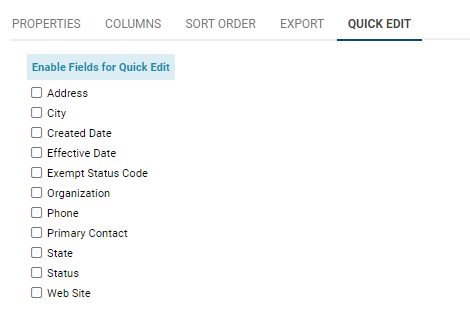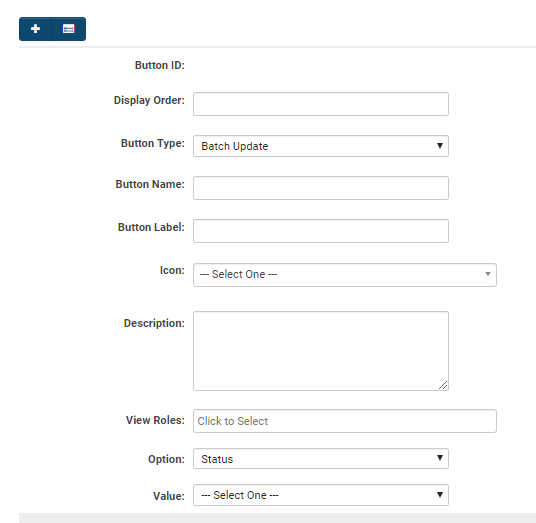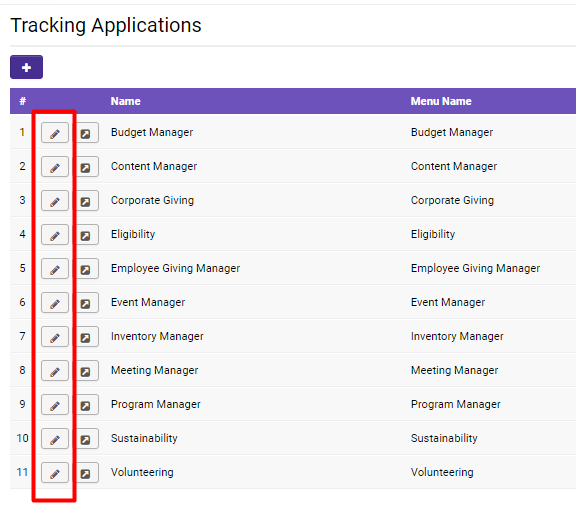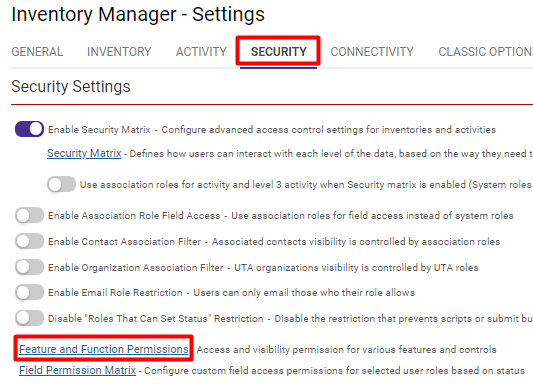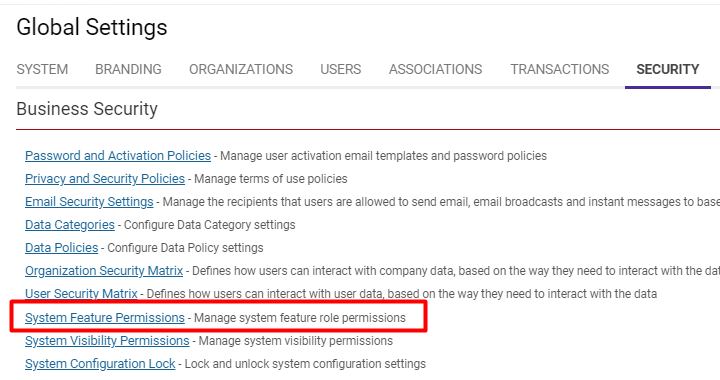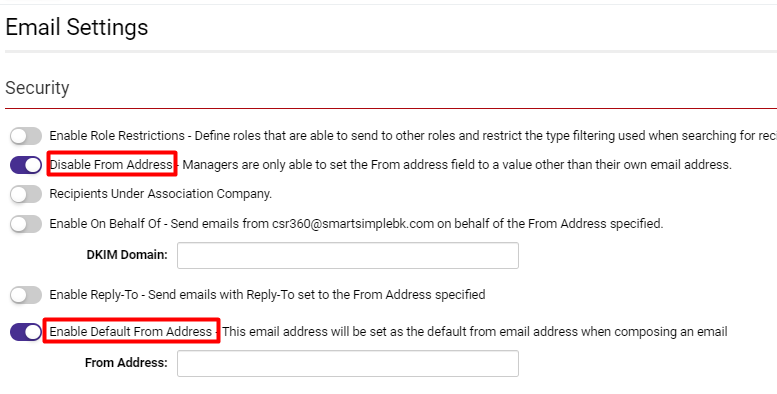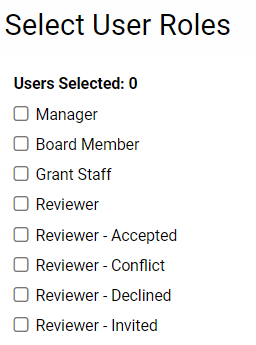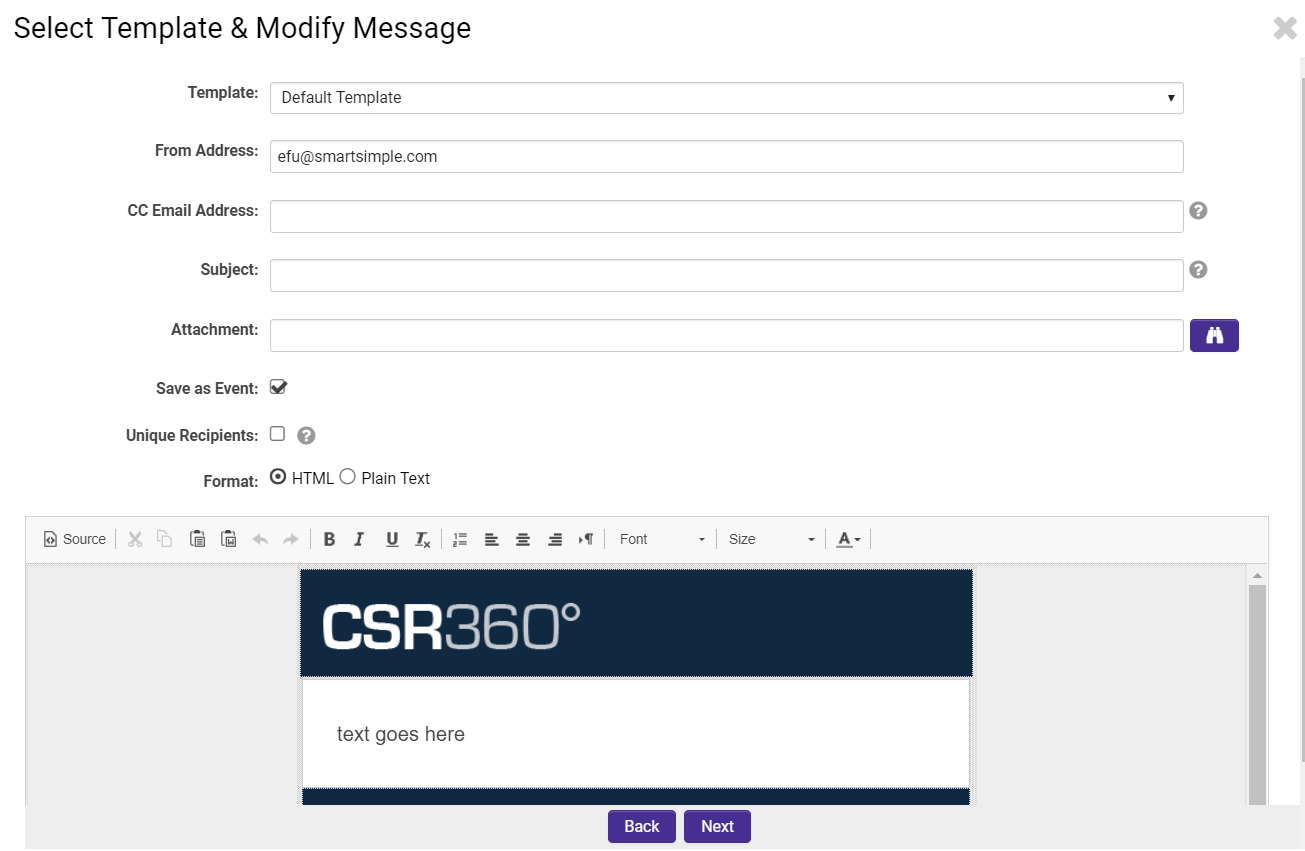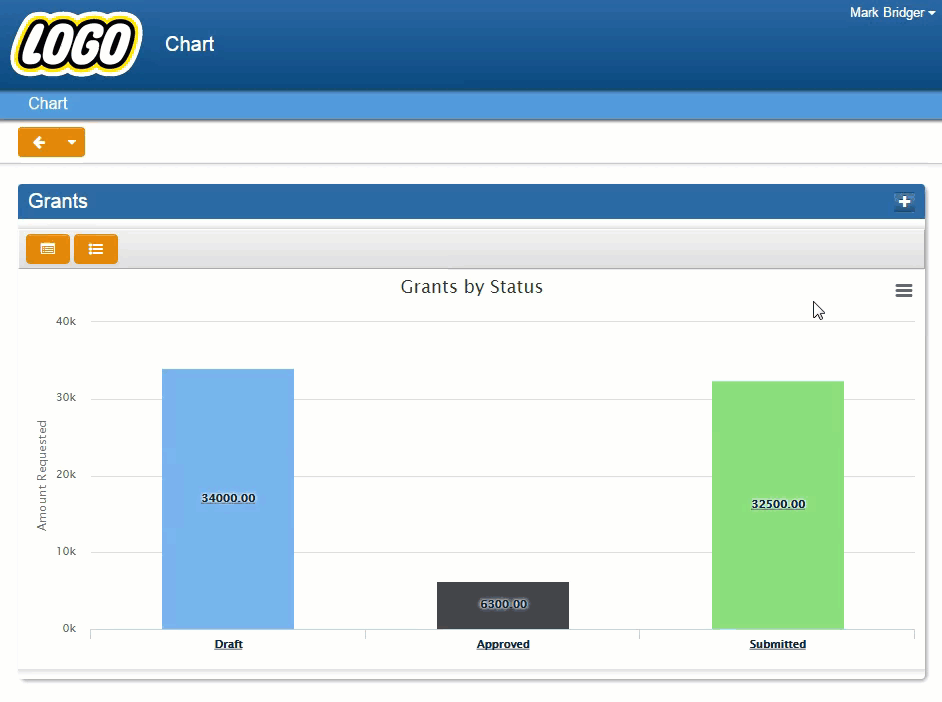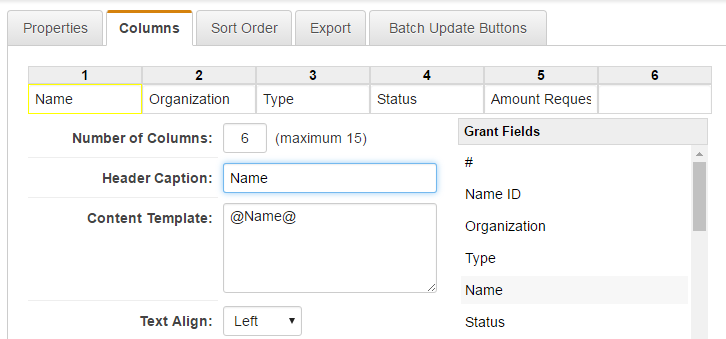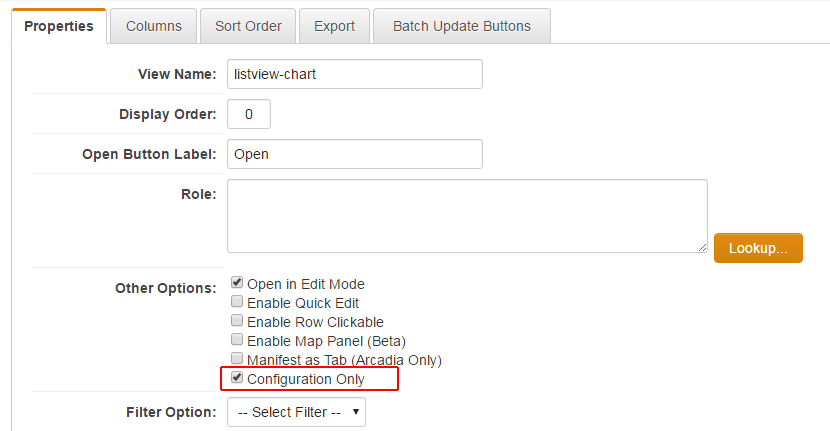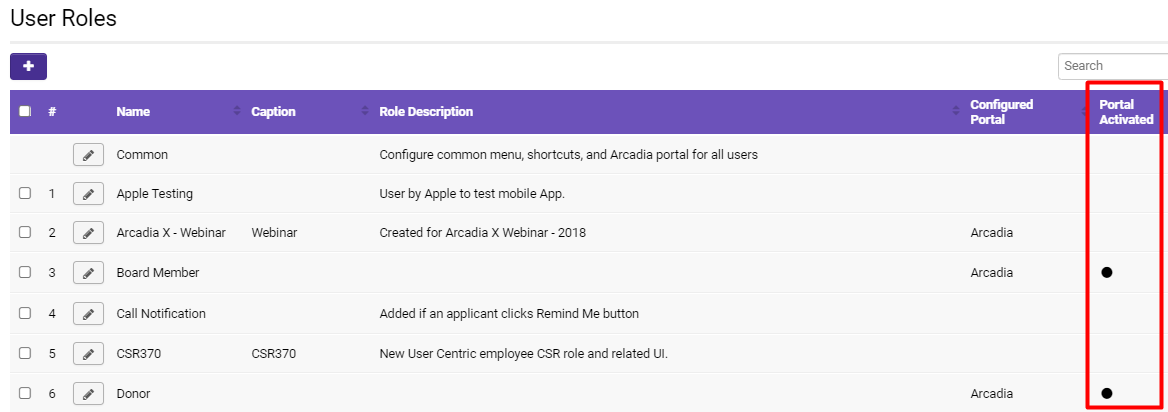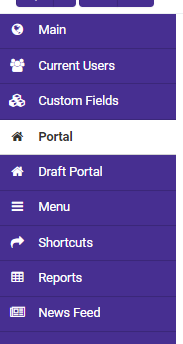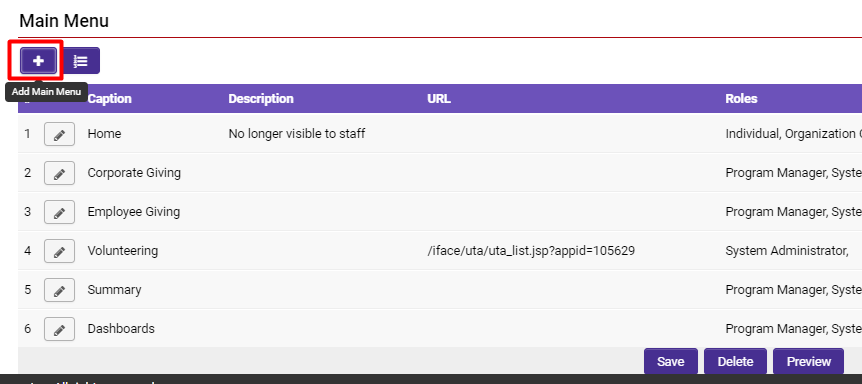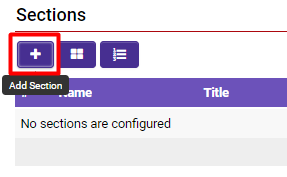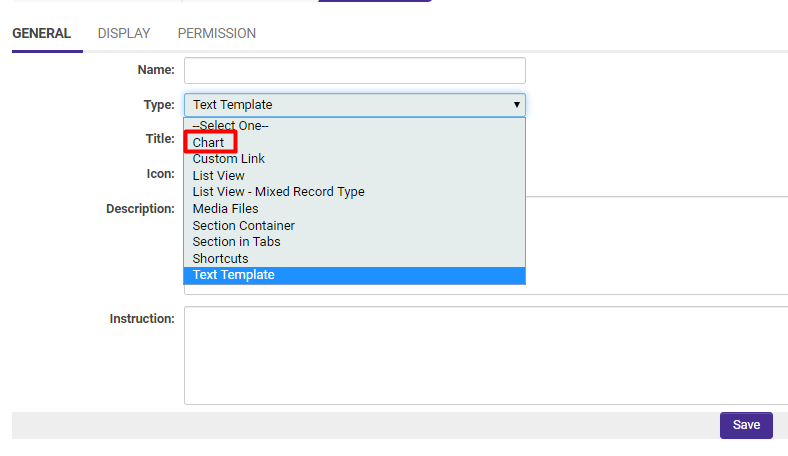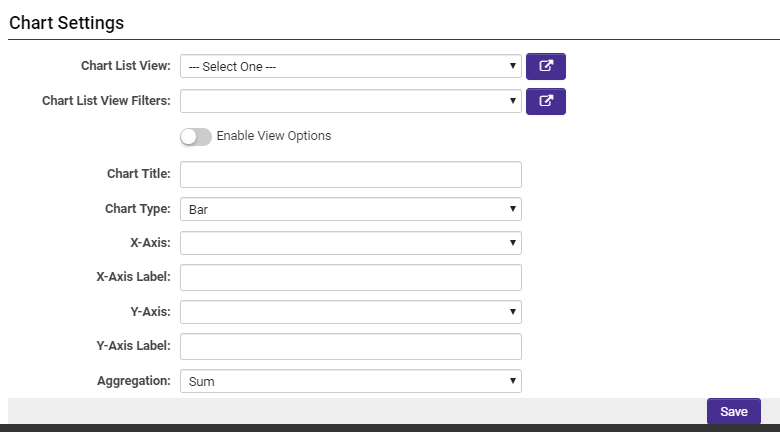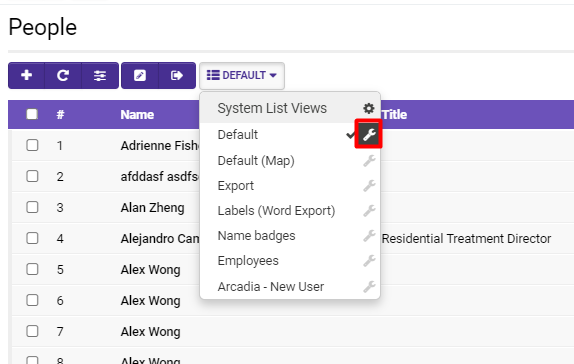List View Overview
Contents
Overview
List views are the part of the SmartSimple interface that combine similar records in a vertically scrolling list. The List View allows you to define which standard fields and custom fields are displayed when viewing a list of records. List views are configurable, so that you can define and customize such factors like the sequence in which records are displayed, the colour formatting of certain records, the number of records that are displayed, and more.
Features of List Views:
- Up to 30 columns of records
- Dynamic Filters — create and combine filters, narrow down by type or status, control date/time options, etc
- Download Files option — download all records from a list view, including attachments
- SmartCard Indicator — collect groups of objects into different SmartCard that can be easily shared with other users
- Group Email — send a group email; for example, mass email a list of applicants from approved applications from a previous year
- Formatting Options — drag and drop sequence of records, format colour and text boldness, group fields to display in a single cell, etc
- Multiple View Options — change list views into dashboards, interactive charts, graphs, etc
- Export to Excel — easily export list views to Excel for record-keeping sheets
- Export to MS Word — easily export list views to Word for documentation
- Portal Shortcuts — use list view aggregations to display on your Portal as a shortcut
- Batch Updates — enable a Batch Updates button to modify all records in a list view at once
... and much more!
For first-time users, it is highly recommended to test List View modification on the Backup Server first.
Configuration—Essentials
A typical external user is unable to edit list views, although they may select between varying list views to change their screen. Only users with the role of System Administrator are able to edit list views.
Note: A Default List View should always remain in the system as a generic list of basic details, with no filter assigned to allow free searching.
Example of List Views
For example, clicking on Organizations from the main menu will display a list view of organization records in your SmartSimple system:
In the above example, the following fields have been selected for display:
- Organization Name, Address, City, State, Phone Number, Primary Contact, Website, and Status (inactive/active)
Each field in this list is able to be sorted differently (default, ascending, descending) by changing the value of the Sort By dropdown box to the right of each field.
The list can also be filtered by using the Basic Search panel which is at the right of the list view, or the Advanced Search panel which, when selected, will open as a modal window where you can customize your search.
Note: List views will default to the last set of search criteria used. For example, if you perform a search within People for contacts with the last name "Smith," the next you log back in and view your contacts list, SmartSimple will remember your search and present the last set of search criteria, in the same sort order.
A user can modify their current list view by selecting the List View Options icon on the top right.
This will open a modal window that allows the user to select or de-select certain fields to be shown in their current list view. The benefit of this feature is that each list view can display a different combination of fields, both standard and custom.
Other options to modify list views can be accessed through the top buttons available on a list view.
The above example shows the following buttons from left to right:
| List View Button | Function |
| New |
The new button, marked by a + icon, allows you to create a new record in that list view. Ex: In a list view of organizations in a SmartSimple system, you will be able to create a new organization. |
| Reload | Clicking the reload button will refresh the page. |
| List View Options |
Current - Allows you to select and de-select which columns you want visible in the list view. Global -
|
| Batch Update |
The Batch Update option allows you to update selected fields of the records on a list view at once.
|
| Export | The Export function, demarcated by a right arrow icon, allows you to export the records on the list view to Excel, SmartFolders, or another Internet-enabled folder. For more, see our Exporting List Views section. |
| List View Options |
The List View options function is demarcated by a list icon and the label Default or a customized name. Clicking this icon will open a drop down consisting of the available List Views, which can be toggled between for differing list views of the records.
|
System Views and Personal Views
There are two types of list views:
| System Views | |
| Personal Views |
|
To toggle between differing Lists Views, including between System and Personal List Views, simply select the list chart icon above your list view. A drop down list will appear that has both the available System and Personal List Views for each user. Each List View is labelled by the user who originally created them.
To edit these List Views, simply select the wrench icon on the left. The details of that list view will be displayed.
Organizations and Users List Views
Below are examples of what Organizations and Users List Views look like.
Above: A list of all the users in the SmartSimple system.
Above: A list of all the organizations in the SmartSimple system.
List views of both users and of organizations can be accessed from the 9-square menu icon on the top right of your page.
Under the heading Organizations, select People for a list view of users, and Organizations for a list view of organizations.
To configure the list views of users and organizations, follow these steps:
1. Click the 9-square menu icon on the top right of your page.
2. Under the heading Configuration, select Global Settings.
3. Under the heading of either Organizations or Users, scroll down to List View Settings.
List Views in a Universal Tracking Application
Within the Universal Tracking Application, the Settings page allows you to define the list view for Level 1, Level 2, and Level 3 records, as well as the Accounts and/or Contacts section on the Level 1 records if the Contacts/Accounts Standard Fields have been enabled.
- Note: The List View defined for Level 2 will apply both to the list view on the Level 2 tab and to the list of associated Level 2s at the bottom of a Level 1 record, if shown. This will appear similarly for the Level 3 list view that is listed at the bottom of a Level 2 record.
To configure a list view of an application, open the application and select the cog icon on the top of the page that enters Configuration Settings.
In Configuration Settings, the List Views will be available under the appropriate tab depending on the Level of the entity. The Level 1 Entity will be available on the first tab after the General tab, and so on. The nomenclature will differ depending on the labels associated with that application.
Configuring List Views
Clicking into a specific List View will open up the details for that List View. The menu for configuring list views is displayed at the top of the page with different tabs:
Each tab allows different editing functions. Each tab and its functions will be explained in detail below.
Properties
Functions of Properties:
| Feature | Description |
| View Name |
The name of the list view is editable. Give your list view a distinct name that you will be able to remember and associate with that list view.
|
| Display Order |
Enter a display order. This will define which list view will be the default for users who possess multiple roles. List views with lower display order numbers will be displayed before those with higher display orders. Ex: If you want your Default List View to show up first on the list of list view options, you could set its display order to 1 (or any other amount that is lower than all other list view display orders).
|
| Role Permission | Set which roles you want to have access to this list view. Setting roles is helpful if you know that multiple users will access what you're creating a list view of - for example, you can select Everyone, or Employees only. If it is a list view containing information only pertinent for System Administrators, for example, then you can set that role and restrict this view from others. |
| Filter Option | Select which Filter you want to set on this list view. Filters can be saved and stored through Advanced Search, and are labelled by their creators. They can be used as System Filters or Personal Filters. |
| View Style |
List - The typical list view display, where records are displayed horizontally by their associated details and vertically to each other Grid - Records are displayed in a grid-like style, with each record displayed in a square. Ideal for records with uploaded images. Tree - Records are displayed in a hierarchical manner where associations between each other are displayed
|
| Card View Style (Mobile/Grid) |
Note: This feature should only be used if you have enabled the Grid View Style Choose to display uploaded images on each record as Full, Large, or Small and/or Above, Left, or Right of text Tip: Ensure that there is a sufficient amount of images uploaded for the records in order for the Card View Style to look reasonable; otherwise, records without images will show up as a blank square. |
| Manifest as Tab |
Different list views will appear as a separate tab that can be toggled back and forth, rather than the user having to select the specific List View from a drop down list. Note: This option is not always recommended because of its overuse of screen real estate. |
| Hide Filter Search Text | This option will not display the Filter Search Text in a list view; for example, if a System Administrator sets a specific Filter on a list view but does not want users to know what that filter is, you may select this option. |
| Default Buttons |
Useful for lists where you would need to do a lot of batch updates. Buttons available are under the Feature Options heading. |
| Feature Options: |
Open in Edit Mode: When records are opened, they will default into Edit Mode as opposed to View Mode.
Enable Quick Edit: List View will be configured with the Quick Edit feature enabled; fields of records can be edited directly from their List View. Enable Row Clickable: Each row will act as a clickable button to open the referenced record easily. Enable File Download: Displays a download option to allow downloading of files from single file or multiple file fields on the selected records.
Enable Map Panel: Takes each record on a list and plugs in the associated client's address to create a geographical visual of where the clients are. This feature converts address details into latitude and longitude coordinates and integrates with Google Maps. Marked as Configuration Only: The option for the list view is excluded from the drop down for Universal Tracking Applications. Useful for when building multiple list views for an external portal; the list views are accessible only through the cog wheel at the top of the list views drop down. |
| Translated Data Language | Select which language you would like the records' data to show up in. |
Columns
-
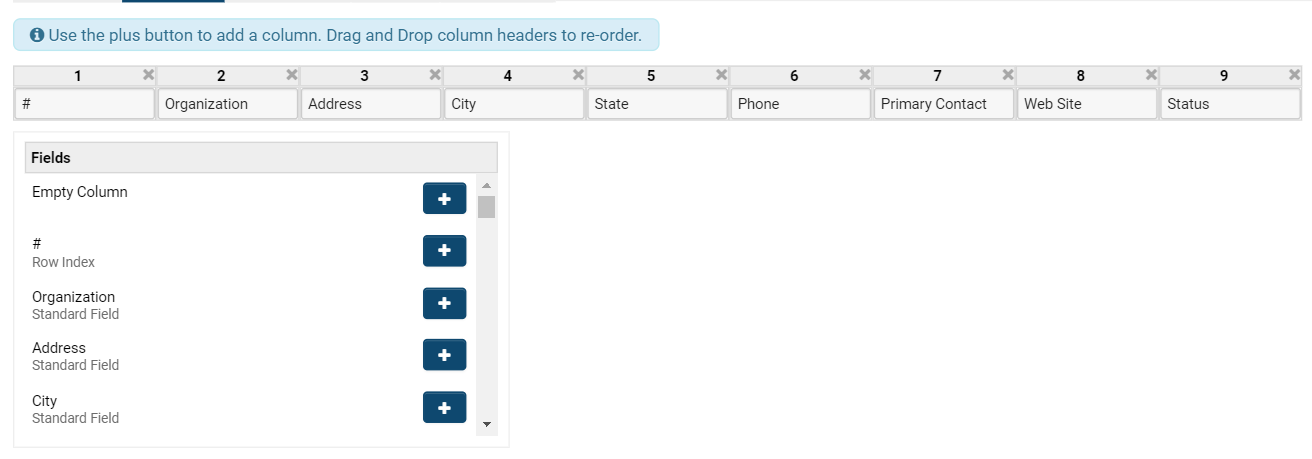
- The Columns tab allows you to visually configure the available columns to a List View. The standard and custom fields that you want to be displayed in your list view are defined here. The maximum is 30 columns to a list view, but best practice is to only display up to 10 columns, as otherwise the user will have to scroll back and forth horizontally and it is a less presentable record, as the platform is responsive on all devices including mobile screens.
-
-
- Note: A single column can contain multiple field values which can help accomodate the 10 column best practice limit.
- You may Drag and Drop columns to reorder them, and by clicking the X on the top right of each column you can delete them from the List View.
- List views are highly configurable: you may bring in fields from different areas such as Applicant Fields, Organization Fields, and so on. They will all be displayed underneath the Fields heading and can be scrolled through.
- By clicking into a cell, you will see the configuration options below.
- In this example, clicking into the Organization cell will highlight the Organization standard field and open up configurable options for the user to fill in.
-
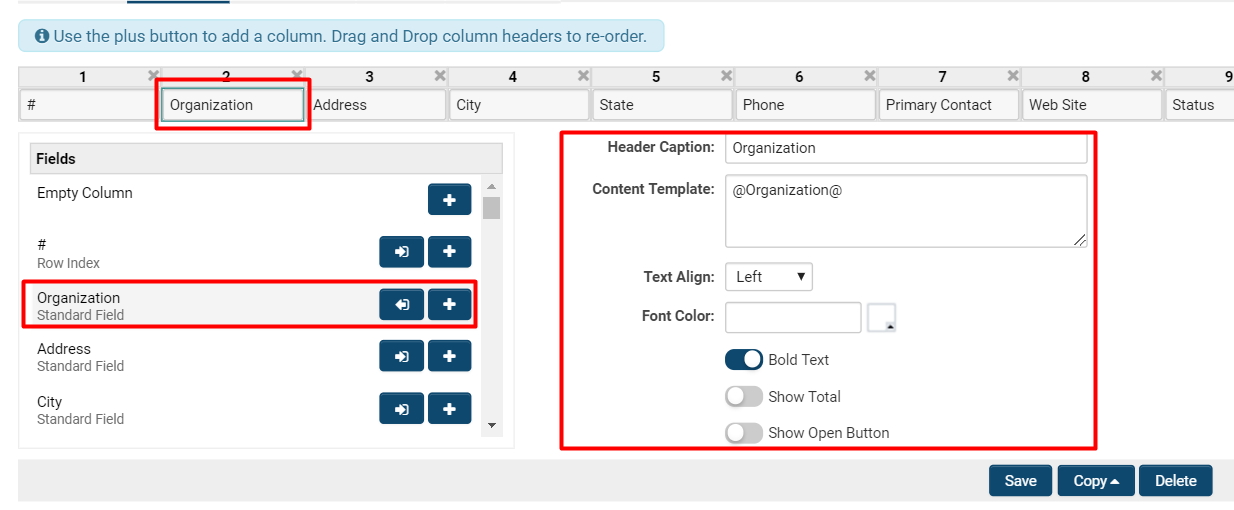
| Column Configuration Option | Description |
| Header Caption | This will appear as the column's label. |
| Content Template |
This displays the variables for each column's information. Note that multiple standard fields can be added in a single column; the content template will reflect how many fields are in a single column by including the variable for each added field.
|
| Text Align | You may choose whether you want the text in a column to align on the Left, Right, or Center. |
| Font Colour | Select which font colour you want the column's information to appear in. This is helpful for columns where you would like to draw the user's attention to, such as the amount requested in a grant, or the status of an application |
| Bold Text |
Allow the column's information to appear bold. |
| Show Total |
Toggle on this option for numerical information in which the column should display a total amount. This option is only relevant for numeric fields, and most commonly used for currency fields. |
| Show Open Button |
This will enable an open button in that column so that the user can open into that record.
|
Multiple values can be added in each column. Once you click a field, a new left arrow icon will appear on the right of the other standard fields. To add another field into one column, select that icon.
In this example, the Primary Contact is added to the same column as the Organization name, so that they will appear together in the List View.
On the right, you will see that the variable for the Primary Contact will show up in the Content Template box. To make the Primary Contact information appear below the Organization name, simply format the Content Template that way.
To clear a column with multiple values, click the X button on the top right of the column box. To remove a single field from a column with multiple values, select the left arrow icon on the right side of that field from within the Fields list.
Once you are done configuring your List View, you can select the Copy button at the bottom of the page in order to copy the List View as a System or Personal View. It is best practice to begin by making a copy, particularly if working from the Default List View, in order to not lose changes and to leave the original view as is.
- Remember, making your list view a System List View will allow other users in your SmartSimple copy to use this list view. Making it a Personal List View will mean that only you have access to it, although you can choose to make it public so that others can view it; further functions, however, cannot be undergone even with a Personal List View that is made public.
Sort Order
-
- Ascending will sort the selection from A to Z alphabetically or 0 to 9 numerically.
- Descending will sort the selection from Z to A alphabetically or 9 to 0 numerically.
Note: The Sort Order options only define the default sort order for the list view. The list view can always be re-sorted by using the Sort By feature within the list view.
Export
The Export tab will display all the functions and options available to users for exporting their list views. A user is able to export a list view with the Export button on the top right of their list view.
Enabling the Export button will allow you to export into Excel, the default exporting program.
If you want to export into an Internet-specific folder, such as a Configuration or SmartFolder, you can select that from the drop down menu. You can look up specific folders that currently exist in your SmartSimple system by selecting the Binoculars icon.
-
- Update Status After Export: Each exported record will be updated to the specific status.
- Trigger Workflow After Export: Each exported record will trigger the specified workflow.
- For more information: Workflows Overview
In the next sections of the Export page, you can customize the settings for exporting to Excel.
Tip: The default settings in the system are normally sufficient.
Note: Excel exportation will not maintain personalized formatting done on the Columns tab, including for instance colour formatting, line breaks where different fields have been included in one cell, and so on. However, once you have exported to Excel, users can freely pivot and customize the formatting on the Excel records.
- If you would like more information on MS Excel Settings, see Positioning Exported List View Results in your Excel Spreadsheet
- MS Word Settings: Enter semicolon-delimited list of MS Word Merge field names (fieldname1;fieldname2;fieldname3)
Custom Export Settings:
| Custom Export Setting | Description |
| Header | Define the text and column settings that will appear above the main body of the exported list view |
| Record Template | Define the columns from within the list view that are to be exported |
| Footer Template | Define the text that will appear below the main body of the exported list view |
| Default Filename | Define the name of the exported file |
| Export Values Only | Will strip out any formatting (ex: commas, currency, decimal places) associated with the selected field |
Quick Edit
The quick edit tab allows you to enable particular fields for Quick Edit, allowing users using the list view to edit fields on a record directly.
Configuration - Advanced
Batch Update Buttons
For more information on Batch Update Buttons, see Batch Update.
On list views related to Universal Tracking Applications (that is - not Organizations or Contacts List Views, like those we have been working with), Batch Update Buttons can be enabled. Once you are in configuration mode for a List View, you will see a fifth tab on the menu that will allow you to create Batch Update Buttons. Clicking on this menu will open up a list of available Batch Update buttons. To create a new button, click the + icon.
The criteria to define for each button is explained below:
| Display Order | This determines the position at which the Batch Update button will display in the drop down list of available Batch Update buttons. A lower numerical amount (ex: 1) will ensure that this specific Batch Update button appears first on the list. |
| Button Type |
Batch Update - This will enable an option to mass update all selected records at once. Copy - This will create a duplicate copy of the information of selected records. |
| Button Name | Provide a name for your button. Ex: The name for a button that changes the status for grant applications from submitted to approved can be appropriately named Approved. |
| Button Label | Provide a label for your button; typically, it is the same as the name. |
| Icon | An icon is extremely useful to draw attention to the button and to communicate its use to users. Ex: A dollar sign icon for an Approved button for grant applications. |
| Description | Always write a brief description so that other System Administrators and users can understand the functionality of the button. |
| View Roles | This criteria is particularly important as it will determine who is able to access this button when on the specified List View. Clicking into the text box for View Roles will allow you to select which roles would be able to view the Batch Update button. |
| Option |
Select from a number of types of what you want your button to perform. A common use case is for the Option function to depend on Status - for example, on a List View of grant applications, this Batch Update button will change the status of all selected records at once.
|
| Value | The value corresponding to the option that you have chosen for your Batch Update button. For example, if your Option function was Status, then your Value would be chosen from a list of available statuses in your system, such as Approved, Declined, Submitted, and more. |
On other list views (such as for Organizations and Contacts, rather than Universal Tracking Applications, you will see an icon to the top right of the list view that enables Batch Updates.
If using Status for your Batch Update button, once you save the button an option for writing a confirmation message will appear. This is not mandatory, but often helpful for users as they can see the batch update progress and confirmation at the top of the screen, but may not be aware of the ramifications: leaving a note on the function of the button will help them decide whether they want to use the Batch Update button or not. Batch Update buttons work based on Role Based Security.
Notes:
- Batch update functionality can also be used to run template formulae, but will override all logic restrictions and trigger workflows
- Batch update buttons are available on UTAs of all levels
- If there are automated processes that may be triggered by a batch update, best option is to open any affected record when in the System Administrator role and select Options >> Workflow History to view the process of triggers.
- If ever in doubt, run the Batch Update Button on your Backup Server and Testing Instance. It is best practice, although not mandatory, for Batch Update buttons to provide one valid progression - e.g. a list view with a predefined filter of all applications in pending approval status, where the last step is to approve them simultaneously and for all notifications to go out at the same time.
Enabling Batch Update Permissions
Usually, batch update is permitted to users in a System Administrator role. There might be another role that should have the batch update function available to them, such as the Program Manager specific to a UTA for programs.
To enable batch update permissions for UTA List Views, you must go to the specific UTA.
1. Click the 9-square menu icon on the top right of your screen.
2. Under Applications, click to the specific UTA you are looking for, or find it under Configuration >> Tracking Applications.
3. Select the cog icon at the top if you are on the specific UTA's page, or select the pencil icon next to the specific UTA if you are on the Tracking Applications list.
Both methods will display the details of that UTA. 4. Under the tab Security, select Feature and Function Permissions.
5. The ability to enable batch update for certain roles should appear as the first line. Click into the text box in order to look up which roles in the system you would like to make the Batch Update functionality available to. Remember, best practice is to only make this function available to System Administrators.
6. Click Save. To enable Batch Update Permissions for Organizations and Contacts List Views: 1. Click the 9-square menu icon on the top right of your screen.
2. Under the heading Configuration, select Global Settings. 3. Under the tab Security, select System Feature Permissions.
4. The Enable Batch Update option should be listed first.
Click into the text box in order to look up which roles in the system you would like to make the Batch Update functionality available to. Best practice is to make this function only available to System Administrators. 6. Click Save.
Group Email
The Group Email function is available for List Views and must be separately enabled.
The group email function is helpful because it gives you the ability to send batches of information to an assigned group in a pre-branded template - including attachments - in a single step, without having to re-enter information for each individual recipient.
This can be done for individual records by selecting the roles within a record you'd like to communicate with, and can be sent from almost any screen within a record where there's a list of contacts.
Choose the specific records, contacts, or organizations under the group email option and the template you'd like to use. You also have the option to include attachments as required.
Once you have everything set up, you can preview the email before hitting Send.
Remember, the default "from" email address will be from the particular administrator logged in as the sender, but that can be easily changed under Global Settings >> Security >> Email Settings.
Group Email for Organizations and Users List Views
1. Click the 9-square menu icon on the top right of your page.
2. Under Configuration, select Global Settings.
3. Under Security, select Email Settings.
Email Settings have a number of functions and options.
| Security |
Enable Role Restrictions - Define which roles are able to end to other roles, and restrict the type filtering used when searching for recipients Disable From Address - Managers are only able to set the From address field to a value other than their own email address Recipients Under Association Company - Allow associated users to be recipients to an email Enable on Behalf Of - Send emails from csr360@smartsimplebk.com on behalf of the From Address specified Enable Reply-To - Send emails with Reply-To set to the From Address specified Enable Default From Address - This email address will be set as the default From Address when composing an email |
| Email Broadcast Manager Roles | Select which roles are able to have manager permissions for emails. These permissions include the disabling or changing of the From Address for emails and more. |
| Restrict Email Access | Select which roles do not have email access for your SmartSimple system. |
| Restrict Instant Message Access | Select which roles do not have instant message access for your SmartSimple system. |
| Failed Email Alert | Write the default failed email alert template, including the From and To Address, the subject name, the body content, and the frequency. |
Group Email for UTA List Views
Group Email for UTA List Views must be enabled from the specific UTA itself.
1. Select the UTA that you want to enable Group Email for from the 9-square menu icon.
3. Once the UTA records are displayed, select the cog icon on the top of the UTA page to enter Configuration Mode.
4. Once you are in Configuration Mode, select the tab Security.
Note: If you want to set Email Role restriction, toggle on the Enable Email Role Restriction feature. This means that on the current UTA records, users can only email those who their role allows. This is set in conjunction with Roles and Security Settings.
5. To Enable Group Email for that UTA, select Feature and Function Permissions.
6. Going on the second tab (labelled differently depending on the Level 1 Entity for that UTA), scroll down until Enable Group Email.
-
- The question mark icon next to the title will give you tips on how to use Logic, should you wish to configure Group Email through that route.
- The Role text box will allow you to click in and select which roles will have Group Email functionality for that UTA.
7. Click Save.
For Level 2 Entities (and Level 3 or higher), this feature can be enabled following the same process. Simply click onto the next tab, which will be labelled differently depending on your UTA.
Sending a Group Email
Once you have enabled Group Email permissions either on a specific UTA or for specific roles for Organizations and Users List Views, the group email icon should now appear when you access that list view.
If no records are specifically checked, the system will assume this function should apply for all records.
Clicking on this icon will open up a modal window to allow you to check which user roles should act as recipients.
After selecting which user roles should act as recipients, click Next.
The Template and Modify Message window will appear.
Here, you can click into and modify the template, From Address, CC Email Address, Subject, and Attachment fields. You can also modify more advanced options for the group email, including whether you would like to save the email as an Event, whether you want to add unique recipients, and whether you want the formatting for the email body to be in HTML or plain text. The preview will appear below.
For more information, see the Group Email page and the Email Category pages.
Configuring Interactive List View Charts
SmartSimple empowers you to create dynamic and impactful charts directly from your current list view without needing to use Report Builder. This feature provides the ability to see the data as tables or charts, as well as being able to drill down into the data for a more granular view.
List View Charts instantly aggregate your data without any need to re-input information.
For example, if you are a Grants Manager program, you might choose to see grants aggregated by status represented in a chart - you can then drill into the charts to see the grants of a specific status further aggregated by type, then flip the view to table and click directly into a specific grant.
Features of List View Charts:
- Immediately downloadable in .png, .jpg, .pdf, or .svg
- 7 descriptive and colourful chart types available
- Chart by status, type, or another value of your choice
- Toggle easily between chart and table view
- Can go directly into the object from a table view
- Eliminates need for reporting processes
- Great for granular views of data
- Useful for on-the-fly presentations or meetings
How to Configure Interactive List View Charts
If your list view does not already exist, then create a list view with the data that you want to chart. Depending on what type of data you would like to visualize (ex: contact information, grants information, etc) then you can access the configuration mode of list views from various parts of the system. See here for a table of how to access different list views for configuration.
If you do not know how to make a list view, see List View Overview#Configuring List Views for an explanation of all the different functions available with list views.
The list view of a UTA Level 1 Entity is shown below.
Note: If your list view is only going to be used for charts, check Configuration Only at the bottom of the Properties page. This feature hides this list view from the View list, but you can still pick it to view when configuring a portal.
After configuring your list view, click the Save button so that it is stored in the system.
1. Next, click the 9-square menu icon on the top right of your page.
2. Under the heading Configuration', select Roles & Security.
3. Select User Roles.
4. Select the Edit button (pencil icon) next to the desired role whose portal you want to display your chart on.
Note: You can tell if a user role has their portal activated if there is a black dot aligned with the portal column. Note: The first row, Common, is the option to modify the menu and portal items for all users rather than to undergo this process based on role-specific functionality. The common portal is beneficially used for basic menu items that do not have advanced security permissions or role-based visibility.
The Portal configuration will be displayed as a tab on the left side menu. If this tab does not automatically appear, ensure that your Advanced Options (top right of page) is toggled on, and click Save to refresh the side menu.
5. On the role's portal page, select the + icon under the heading Main Menu. This will create a new component for the main page that this role sees.
6. Fill out the caption and description of the main menu item you want to add. When selecting Content Type, ensure that you select the Sections option. All other content type options will not allow you to create an interactive chart.
7. After clicking Save, a new heading titled Sections will appear below. Click the + icon to create a new section.
8. This will bring you to a page to fill out regarding the section containing the list view you want to appear as an interactive chart. Fill in the name and other details, but ensure that your Type is selected as Chart. Click Save.
9. The chart settings will appear at the bottom of the page.
| Chart Setting | Description |
| Chart List View | Click into the text box in order to select from the available system list views to display in chart form. |
| Chart List View Filters | Click into the text box in order to select from the available system list view filters that will modify what data is displayed in chart form. |
| Chart Title |
Populate the chart title - go with a naming convention that concisely describes what the chart is visualizing (ex: Grants Funded by Amount). The title will appear on the rendered chart above the visualization of data. |
| Chart Type |
Select the chart type you wish to use. The current options include:
|
| X-Axis | Select the list view column that should appear as the x-axis of the chart. The columns available are the Standard Fields associated with that list view. |
| Y-Axis |
Select the list view column that should appear as the y-axis of the chart. The columns available are the Standard Fields associated with that last view. Note: If the Aggregation Type is Sum or Average, then the y-axis must be a numerical value. |
| X-Axis and Y-Axis Label | Provide appropriate labels for the x-axis and the y-axis. These labels will appear rendered on the chart next to the respective axis. |
| Aggregation |
Select the aggregation type from the available options:
|
| Enable View Options |
Toggling on Enable View Options will allow the user to choose explicitly between which views he wants to see the data in (list, table, chart, etc). Toggling on this option will allow another option, Show Search Panel on List View, to appear. Toggling on Search Panel will allow the user to use Basic Search and Advanced Search on the list view they access from the chart. |
Helpful Tips with List Views
Accessing the List View Configuration Page
Most list views can be edited on the fly, by clicking the wrench icon next to the name of the list view.
Clicking the wrench will bring you to the configuration page for that record.
Below is a guide for the alternate methods of accessing the configuration pages for the list views of various entities.
The nomenclature of your headings may differ depending on your SmartSimple instance. For example, the tab names of Level 1 entity settings will differ depending on the purpose of your UTA. Level 1-3 Entities normally fall in chronological left to right order after the General tab when you are accessing the Configuration Settings of a UTA.
| To Configure the List View For: | Go to: |
| Contacts, System-Wide | Global Settings > User > List Views |
| Organizations, System-Wide | Global Settings > Organizations > List Views |
| Level 1 Entities within a Universal Tracking Application |
1. Go into the Configuration Settings of a UTA (gear icon) 2. Choose the List Views hyperlink under the Level 1 Settings tab |
| Level 2 Entities within a UTA |
1. Go into the Configuration Settings of a UTA (gear icon) 2. Choose the List Views hyperlink under the Level 2 Settings tab |
| Level 3 Entities within a UTA |
1. Go into the Configuration Settings of a UTA (gear icon) 2. Choose the List Views hyperlink under the Level 3 Settings tab |
| Associations |
Global Settings > Association Settings > List Views |
| Workflow Requests | |
| Transactions |
Global Settings > Transactions > List Views |
Using Reports vs List Views
When is it appropriate to use a List View, and when is it appropriate to build a report?
A report is needed if your situation includes at least one of the following criteria:
- You need more than 30 columns
- You need formulae or calculations
- You need more complex aggregations than a simple total (e.g. count distinct, minimum, maximum, sum, group by, total by)
- You need an OData connection or you need to link multiple datasets that are not automatically connected (e.g. multiple UTAs
Notes:
- Reports are more sensitive:
- only 5 criteria are permitted compared to limitless criteria on a List View
- requires more knowledge of SQL and reporting (although fine if a user is familiar with MS Access or Tableau)
- less dynamic
- Reports are more sensitive:
| Determining the Application Tabs Displayed to the User |

